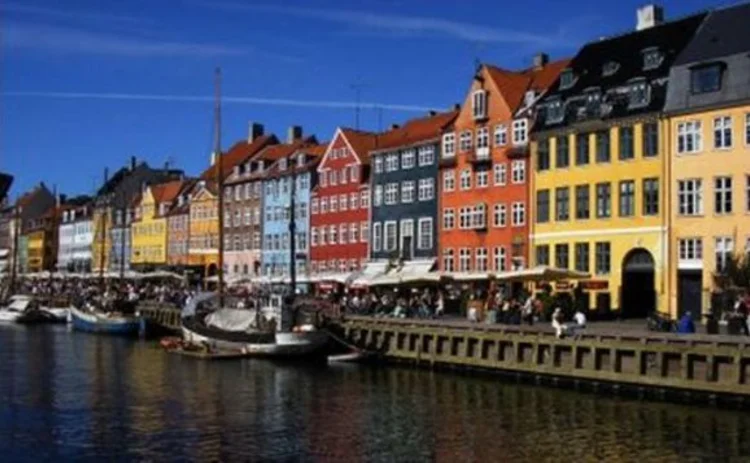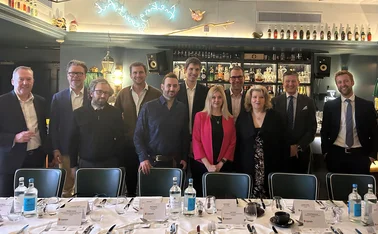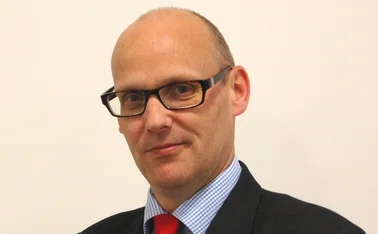
An in-depth review of the general insurance market in Denmark

Denmark’s insurance market, although small, is singled out by some as the most sophisticated in Scandinavia. Ralph Savage reports on how the nation’s players have performed off the back of a testing first half in 2010.
The Danes have a word for that warm, cozy feeling you get when nothing can go wrong and comfort and happiness are the order of the day.
‘Hygge' is untranslatable into English, although reliable sources liken it to the comfort Brits take in knowing that however bad things are, a cup of tea will always take the edge off.
Useful mantra
Such a mantra must be useful in the insurance industry and particularly this year, when much of Denmark's general insurance sector has recorded losses from one of the harshest winters on record.
Satellite images from 8 January show the entire country submerged in snow, a factor that led to its major insurers reporting much higher than average claims activity in their first quarter results.
Ratio problems
Tryg - recently rebranded from Tryg Vesta - is the country's largest insurer by market share and its exposure in the first quarter is starkly illustrated in a combined ratio which spiked to 108.4% against 91.4% in the same period of 2009, the result of DKK 700m (£78.4m) in extraordinary winter claims.
Its rival, Topdanmark added 7.1% to the group's loss ratio in the first half, after DKK 300m of winter related claims hit the insurer's bottom line.
The big four
Denmark's GI sector is dominated by a big four group of companies with a combined market share in excess of 60% (see box). The remaining two of the four, RSA-owned Codan and Alm Brand have steady shares of around 14% and 10% respectively, but the former could be seen as being on something of a march having acquired Tryg's Danish marine portfolio in the first quarter, in addition to assets in Sweden.
Niels-Peder Nielsen, partner at Bain & Company Nordic, says the industry has provided consistent total shareholder returns for a number of years. In May of this year, Bain analysed the TSR of 100 publicly listed insurers around the world with a market capitalisation of at least $500m and found that Topdanmark has generated a 10-year TSR of 19%, carving out a market-leading position as an insurer of SMEs focusing on its home market, and with a particular strength in the agricultural sector.
"The Danish market has been stable like this over the last 10 to 15 years and when benchmarked against other markets it has a relatively high level of sophistication and capability in claims management, distribution and underwriting," says Mr Nielsen.
"Part of the reason for this is we have seen very little of the more disruptive behaviour in the form of attacks by major players looking for acquisitive growth in an imprudent way; the companies have focused on bottom line profitability."
Winter worries
Rainer Fischer, head for the Nordics and Baltics at Swiss Re agrees, but says the winter asked some difficult questions. "Most insurers, whether they're large or small, are writing profitable business. However, this does not include winter claims (2009/2010), which are currently estimated to cost the insurance industry in Denmark between DKK2-2.5bn."
Claims inflation is of concern in Denmark and Swiss Re says fraud is on the rise. "In 2009, we noted an increase in incidences of fraud in motor and household insurance," adds Mr Fischer.
"An estimated 2-3% of motor claims are now fraudulent (for example car theft or car fire). This percentage reflects a noticeable increase when compared to the previous year. In private and commercial property, about 6- 8 % of total claims are now fraudulent."
Fraud factor
Kasper Andersen, a spokesperson for the Danish trade association Forsikring og Pension, suggests the industry is taking notice of this trend. "We do not have reliable data on the extent of fraud in the Danish market.
However, Danish insurance companies spend much more on investigating fraud today than they did 10 years ago."
In comparison to its neighbours, Denmark is seen as highly competitive.
Broad spread
Erik Börjesson, Lloyd's Nordic area manager, explains that Lloyd's business in the country is spread among a broader group of distributors than Sweden, Norway or Finland. "Business into Lloyd's from Denmark in 2009 was around €57m (£47.5m) with 55-60% of the total being primary insurance and the rest reinsurance," he says.
"The dominant part is marine business, which accounts for around 30%; 15-18% is property , the third biggest is aviation (10%) and we have a motor segment too (6%)."
Aviation advantage
Aviation's relatively strong position in Denmark's insurance market owes its place largely to insurer QBE's presence in Copenhagen, where its Nordic operation is based. The Australian company acquired the Danish Aviation Insurance Pool in March 2006, directing around €15m of premium to its Syndicate 5555.
Mr Börjesson adds that the distribution mix in Denmark singles it out from the rest of the region. "22% of this business comes from coverholders and other service companies, which is a bit different to the other Nordic countries, where the coverholder business is around 13-14%. This supports my view about the Danish insurance market being more sophisticated than the rest of the Nordic market.
"This is also reflected by the fact that there is greater concentration in Norway, Sweden and Finland; 80-85% of the business is handled by four local carriers, but in Denmark the control by the four big carriers is around 65%."
High penetration
For all major insurance areas, insurance penetration is generally very high in Denmark, adds Mr Andersen. "For example, uninsured driving is virtually non-existent. And compared to other countries, a very large proportion of cars have comprehensive motor insurance. This is due to very high taxes on motor vehicles, which makes it relatively expensive to purchase a car in Denmark."
Mr Andersen's point regarding the cost of motoring in Denmark cannot be understated; vehicle registration tax on cars is a massive 180% on values above DKK 62 700.
The range of compulsory insurances is broadly the same as in the rest of Europe, with motor liability on personal lines and commercial, while workers compensation insurance and professions also require indemnity. Occupational disease is slightly different, with the Danish government stepping in.
"It is true that payment for occupational disease is covered by a government owned ‘company', or fund." explains Mr Andersen. "Workmans' compensation is covered by traditional insurance in Denmark, covering occupational ‘injuries' as opposed to disease claims."
Broker bond
As Mr Börjesson at Lloyd's comments, Denmark is relatively well represented by intermediaries, both brokers and coverholders. The personal lines marketplace has been almost completely disintermediated but commercial has a strong influence from them.
"Willis is biggest, then Aon, then Dahlberg and Marsh. There are also a number of smaller broker operations with 10 to 15 people," he explains. "On the coverholder side, there are three service companies and five coverholders. The biggest coverholder is Dahlberg; it is quite rare for a broker also to have a binding authority in the Nordic region, but again in Denmark they are innovative and Dahlberg is an example of one major company conducting both types of business."
Rating issues
Denmark's ability to generate returns from its insurance sector is not always a simple story to explain, however. With stability has come a rating environment that is seen as relatively cheap says Mr Börjesson. "When I was working with a broker previously and I would come to London with a piece of business; we would tell them what the premium would be and the market would generally respond that it appeared to be too cheap. But if you look at these Nordic carriers even if the rates are maybe 30% lower than UK rates, the results are very good at the bottom line.
"If you build a portfolio of Nordic risks with good underwriting, it is profitable business - maybe not the lowest combined ratios, but it is stable over time. The reasons behind this is that exposures for natural catastrophes are quite limited; the risk management standards are very good - not just at big multi-national companies but in general, in the whole society risk management standards are good.
Quality of construction
"The third argument is that we have less exposure to litigation and suing people is much less common here than in other parts of the world. Finally, the infrastructure is such that all buildings are designed for the winter season - the quality of construction is very high."
Nevertheless, many of the primary insurers are implementing rate rises, with Tryg in particular fielding questions on this subject regarding its motor book from analysts at its H1 results on 17 August. The insurer's motor claims ratio of 74% was described as ‘extraordinary' by one analyst so how could it convince the public that rate rises are justified?
New tariffs
Tryg's H1 report explained: "The average premium on motor insurances has declined in the last few years in Denmark due to the implementation of new tariff parameters including annual mileage, the age of the car and security equipment. The new parameters have been implemented and thus average premiums are expected to increase."
Stine Bosse, group chief executive officer of Tryg, then declared: "All of our peers in the market - either they have put through premium increases, or they are in the middle of doing so."
Morten Hübbe, group chief financial officer at Tryg, added: "This transition period [when new tariff perameters were implemented on the motor book] took down the average price and this phase is now coming to an end. After that we will see more normal annual indexation of prices which means we are not carrying out bigger price increases because profitability has returned."
Profitable market
Topdanmark announced price increases that reduced its overall claims ratio by 1.7% and the company reported on 25 August that this had "generated a slightly larger than expected loss of SME customers, while the attrition of personal customers was more limited."
So with such a generally profitable market, stable claims ratios, a limited risk of litigation and good property risk management, it's a wonder why only RSA has made a significant play in the market.
Barriers to entry
However, Mr Nielsen says there are some barriers to entry. "A couple of relatively major Nordic players have come in, such as IF (part of Sampo), but by and large the more successful models have been achieved because they have a sophisticated approach to direct distribution and claims handling. It's tough to come in to the Danish model and attack the market unless you do so on price, but there have been some attackers on price, ALKA, for example.
"The fact is, Tryg is majority owned by a foundation and there have been some discussions around its ownership but basically it is not directly accessible as an acquisition target," adds Mr Nielsen. "My sense about Codan is that RSA has a strong commitment to the Nordic market and accordingly it is making good profits. Topdanmark has a very loyal base of shareholders and I don't think there's any speculation around it being acquired."
Fragmentation factor
However, outside the big four, Denmark's insurance market is extraordinarily fragmented with a collection of more than 30 very small underwriters holding between 0.1-1.5% market share, a fact that could lead to consolidation, says Mr Fischer.
"There is still very little consolidation in the market. Solvency II may spark consolidation around small mutuals, and we expect to see further market consolidation in general."
Historically an agricultural and export-led economy, Denmark's urbanisation has seen the population leave the countryside and head for the major centres as fewer hands have been required to work the land. If this continues, Mr Fischer's suggestion that small mutual insurers' days could be numbered makes sense.
Customer loyalty
However, this may not account for the traditional outlook and commitment to community felt by many people in this country of only 5.5m inhabitants. Perhaps these micro-insurance companies will retain their loyal customer base and help maintain the sense of ‘Hygge' experienced by Danes for some time to come.
Danish companies gross written product and Market share for 2008
Company - GWP (DKKm), market share
TrygVesta - 9 552 ,20.7%
Topdanmark - 8479, 18.3%
Codan - 6417, 13.9%
ALM Brand - 4690, 10.1%
If - 2298, 5%
Sygeforsikringen - 2247, 4.9%
Lærerstanden - 1680, 3.6%
ALKA - 1589, 3.4%
Nykredit Forsikr - 1366, 3%
GF-FORSIKRING - 1274, 2.8%
*source - Forsikring og Pension
Only users who have a paid subscription or are part of a corporate subscription are able to print or copy content.
To access these options, along with all other subscription benefits, please contact info@postonline.co.uk or view our subscription options here: http://subscriptions.postonline.co.uk/subscribe
You are currently unable to print this content. Please contact info@postonline.co.uk to find out more.
You are currently unable to copy this content. Please contact info@postonline.co.uk to find out more.
Copyright Infopro Digital Limited. All rights reserved.
You may share this content using our article tools. Printing this content is for the sole use of the Authorised User (named subscriber), as outlined in our terms and conditions - https://www.infopro-insight.com/terms-conditions/insight-subscriptions/
If you would like to purchase additional rights please email info@postonline.co.uk
Copyright Infopro Digital Limited. All rights reserved.
You may share this content using our article tools. Copying this content is for the sole use of the Authorised User (named subscriber), as outlined in our terms and conditions - https://www.infopro-insight.com/terms-conditions/insight-subscriptions/
If you would like to purchase additional rights please email info@postonline.co.uk
Most read
- Aviva CEO warns home insurance premiums need to go up
- Integration and restructuring costs push RSA to 2023 loss
- Which urges FCA to take action on premium finance following investigation








